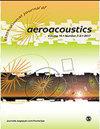Role of nozzle-exit boundary layer in producing jet noise
IF 1.3
4区 工程技术
Q3 ACOUSTICS
引用次数: 4
Abstract
Often the measurements from different jet noise studies, which are thought to have been acquired at or corrected to identical jet conditions, do not match when compared to each other. This study looks at the nozzle-exit boundary layer as a possible factor for these differences. The nozzle-exit boundary layer state can easily be changed depending on the design of the jet-facility or the nozzle. To this end, jet noise measurements and nozzle-exit velocity profile measurements were acquired for nozzles where the nozzle-exit boundary state was changed either by using different types of nozzles, ASME nozzles versus conical nozzles, or extensions were added to the nozzles straight section. It is shown that as the laminar boundary layer transitions to turbulent, the high-frequency jet noise is reduced. In addition, development of a novel empirical correction for these effects was attempted.喷嘴-出口边界层在产生射流噪声中的作用
通常,来自不同射流噪声研究的测量结果,被认为是在相同的射流条件下获得或校正的,在相互比较时并不匹配。本研究将喷嘴-出口边界层视为造成这些差异的可能因素。喷嘴-出口边界层状态很容易因射流装置或喷嘴的设计而改变。为此,通过使用不同类型的喷嘴(ASME喷嘴与锥形喷嘴)或在喷嘴直截面上增加扩展部分来改变喷嘴-出口边界状态的喷嘴,获得了射流噪声测量和喷嘴-出口速度剖面测量结果。结果表明,当层流边界层向湍流过渡时,高频射流噪声降低。此外,还试图为这些影响开发一种新的经验校正方法。
本文章由计算机程序翻译,如有差异,请以英文原文为准。
求助全文
约1分钟内获得全文
求助全文
来源期刊

International Journal of Aeroacoustics
ACOUSTICS-ENGINEERING, AEROSPACE
CiteScore
2.10
自引率
10.00%
发文量
38
审稿时长
>12 weeks
期刊介绍:
International Journal of Aeroacoustics is a peer-reviewed journal publishing developments in all areas of fundamental and applied aeroacoustics. Fundamental topics include advances in understanding aeroacoustics phenomena; applied topics include all aspects of civil and military aircraft, automobile and high speed train aeroacoustics, and the impact of acoustics on structures. As well as original contributions, state of the art reviews and surveys will be published.
Subtopics include, among others, jet mixing noise; screech tones; broadband shock associated noise and methods for suppression; the near-ground acoustic environment of Short Take-Off and Vertical Landing (STOVL) aircraft; weapons bay aeroacoustics, cavity acoustics, closed-loop feedback control of aeroacoustic phenomena; computational aeroacoustics including high fidelity numerical simulations, and analytical acoustics.
 求助内容:
求助内容: 应助结果提醒方式:
应助结果提醒方式:


